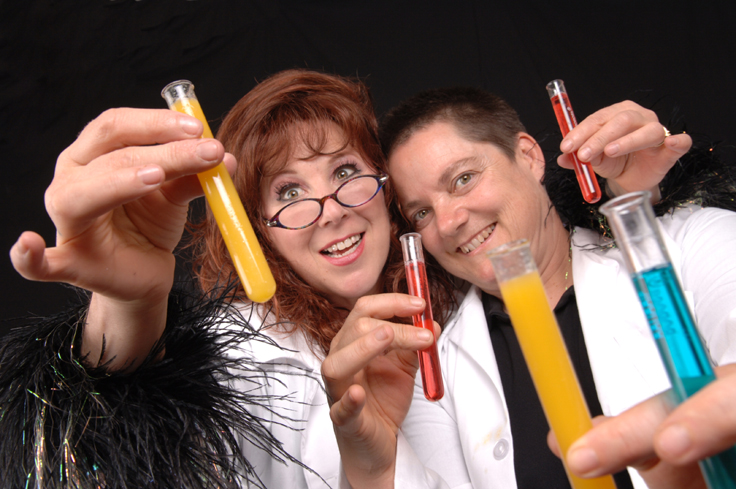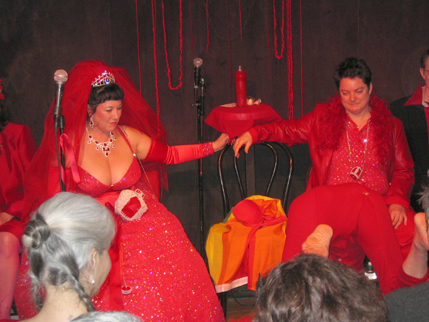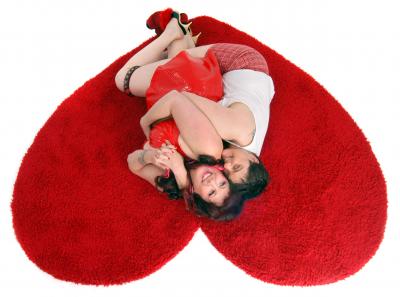Design And Performance Lab
|
Exposed Elizabeth Stephens and Annie Sprinkle The International Workshop Festival/The Chelsea Theatre, London September 19-22, 2007
Johannes Birringer (c) 2007
[Photo by Trish Tunney]
The ancient playwrights knew that women can get rebellious when men spend most of their time fighting wars and squandering the common wealth (Aristophanes's Lysistrata). We also remember the times when protesting on streets against unjust wars was a common enough practice, even though the anti-Vietnam War rallies have now faded into distant memory. A new strategy is proposed by Annie Sprinkle and Elizabeth Stephens's "Love Art Laboratory," an altogether unusual scientific project poposal to experiment with "the practice of exhibiting love as a powerful antidote to violence" that can "engender both hope and healing" (Love Art Lab manifesto). I'd be forgiven to think that the old rock 'n roll slogan Make Love Not War had served its time, yet when the "lab" came to London, I rushed to see its demonstrations since my body and spirit remembered only too well the pleasantly saturated sensorial experience and erotic charge of the Post Porn Modernist show Annie Sprinkle toured in the 1990s. Back then, the former porn star, proud prostitute, stripper and sex worker activist-turned-performance artist managed to rally her audience into the willing suspension of disbelief in the power of communal orgasm. I recall her successful sweeping of New York City's downtown and post-Stonewall gay, lesbian and feminist audiences; many stayed after the show to have their picture taken with Sprinkle's luscious breasts adorning their heads like a crown of honor. Her latest film, Annie Sprinke's Amazing World of Orgasm, has now been released as an experimental "documentary homage" to such community service. The tape was for sale in the lobby, we were told. Before entering the theatre, however, the first transaction happened when we encountered the "lab assistants," who mixed with the crowd in their white lab coats and asked politely for some creative writing to fill in what we thought might be the missing conclusions to questions about art, love, sex, and death. Dutifully, like in a doctor's office, we obliged and offered some writing which the performers later integrated into a show that was also divided into these four building blocks. The lab experiment, then, took off with a public-private participatory action, a key strategy used throughout the evening in Exposed. In the age of interactive media art, Sprinkle and Stephens turned a new page of retro-engineering an old form of story-telling - and asking our view-points about it - mixing their lecture-performance style with a gentle, cabaret-like theatrical call-and-response structure which worked superbly well, however much the critical scientific mind might struggle with the gentle, heart-warming approach the performers take to any artistic pretension or political mine field. Mine fields there were a-plenty, and exposing view-points on very large themes like love and death would appear to be no small task. But as soon as Sprinkle and Stephens enter their lab space - configured like a bed-room with two small video monitors framing the queen-sized bed, a projection screen upstage and prop tables/costume racks left and right - the two ceremonial mistresses greet us and take us on a ride which leaves little room for doubt. We are included in this history, in the "writing" of this performance and the stakes it raises about the art of love. There are no warning signs about indecent exposure, and Sprinkle tells us we are free to use the bathrooms when needed. Fascinatingly, this autobiography is recited in a simultaneous duet with Stephens recounting her life in art school, her academic study of "female objectification" and "the male gaze," and her becoming a professor while roaming the San Francisco bay area as a "wild Diesel Dyke." This coupled duet, which is well paced and modulated, anticipates their falling in love when their paths cross at a queer arts festival in the late 1990s. Sprinkle, wearing a soft, deeply cut dress, tells us with a wink that she had become a lesbian at that time, and when they go on a date, their butch-femme relationship is ushered in. "I got tenure," Beth mentions casually, "but our most creative work took place in bed," with Annie adding that they began to practice drawing their pussies after waking up and "extreme kissing" - which they now also teach to others (an Extreme Kissing workshop was given by the Lab during their residency in London, culminating in a long 2-hour public Kiss-in). The echoes of activism cannot be overheard, and after the SEX section, disclosing some of the baffling commentaries written by audience members, the performers raise the subject of Bush's War on Terrorism after 9/11 and pose questions about what to do in times of war. Since conventional methods of protest seem ineffective, the artists propose the experience of the seven chakras as an alternative in "love-art," asking us to recall this ancient practice of Tantric symbolization of the centers of energy or emanations of spirit. Asking their lab assistant to undress, whereupon Jay Stewart reveals himself to be a f-m transsexual, they paint the different colors of the chakras on his body to mark the vital areas of spiritual energy, of courage, compassion, love, wisdom, etc. This is a peculiar and poignant moment in the performance, as we are torn between whatever mixed feelings we might have about esoteric knowledge, the naivete of such a proposal as a form of political protest, and the plain fact that we are witnessing a vulnerable transgendered body in full exposure in front of the community. Exposed now reframes the political subtext (we had just seen documentary footage of the U.S. invasions of Afghanistan and Iraq), shifting to the violence of discrimination via domestic right-wing or legislative opposition to gay weddings. The section on LOVE, which again articulates the writings from audience members recited over the soft plaintive sounds of a double bass, creates a sentimental moment of reprieve, but the show now moves into the most recent, and quite turbulent, history of the performance couple as they ponder the consequences of the anti-gay amendment to the U.S. Constitution which blocked their attempt to get legally married. Exposed veers wildly between high and low points in these final phases of LOVE and DEATH, but the contrapuntal technique is barely obvious, except as an undercurrent and an unacknowledged tension, since the performance carries a light-hearted melodramatic make-up that makes us laugh and, above all, admire the creative chutzpah with which these women deal with the situation. Determined to get married anyway, they follow a suggestion by Linda Montano (known for her long-durational living concept art pieces) and adopt Montano's Seven Years of Living Art project as the vehicle for the Love Art Laboratory during which they would perform getting married every year for seven years, following the color cycles of the chakras.
[The "Red Wedding". Photo by Les Barany] In 2005, Sprinkle tells us, they prepared for Year One (in red), inviting friends to help them stage an elaborate wedding performance ceremony. The slides of the "red wedding" (with Fluxus artist Geoffrey Hendricks acting as "priest") appear on the screen. We wipe off our tears of laughter as Stephens reenacts HendricksÕ standing on his head during his "invocation without words," as Sprinkle roams around the space adorned with crown and red chiffon bridal veil. But again the mood is undercut when the performers ask whether there are any objections to their vows, or against the "institution" of marriage generally (no protest in the audience, only some mutterings about the dangers...), and the following vignette sends up the pros and cons in a charmingly grotesque skit in which Stephens comes home after a bad day in the office, with Sprinkle (donning an apron and enjoying the life of the homemaker) rushing to cheer her up with applying make up to her loved one and asking her to pose on the bed for some relaxing sexy photo shoots to make her feel better. Their desire for children growing, they then perform an even more grotesquely funny sequence of attempts at artificial insemination, demonstrating to us all manners of sperm donor profiling, favorable Yogic love positions for insemination, and orgasmic methods while volunteers from the audience are asked on stage for a bizarre sperm dance (alluding to Woody Allen's movie about what you need to know about sex). After these exhausting tribulations Š an apparent pregnancy, tested in Austria where Stephens is declared schwanger, turns out to have been premature good news - Sprinkle bares her abundant breasts for a soothing massage applied by her lover, but we are startled by the bad news of Annie's breast cancer diagnosis, projected in stark medical images on the screen behind. Their struggle with DEATH brings the performance to its concluding emotional tight-rope walk, where the artists' contrapuntal technique again steers us from a recognition of physical vulnerability and mortality to a heightened empathy with the resilience they display as Sprinkle undergoes chemo therapy, losing her hair, and Stephens shaving hers off in solidarity, while both decide to turn the medical crisis onto its head by ritualizing the therapy into "chemo-performance," "hairotica," and a "chemo fashion show" during which they dress up in flamboyant outfits and accessories for the infusions. Their outrageous life-and-death style infects the hospital, as we watch their fashion shoots with other patients and nurses who rally around them. The theme of their first year of marriage is "security/survival" - and Sprinkle's successful bout with breast cancer becomes a celebration of the bond and the creativity of the lovers, with Stephens at the end of the show helping Sprinkle to mix a communal love potion for the audience, a "curing elixir" that they share with us while repeating their vows to each other. The artistic side of their treatment of the subject is impressive, although seemingly carried out with only the barest techniques of autobiographical narrative and documentary photography; almost nothing here is acted or faked (apart from the insemination scenes on the bed and the hair-cutting), everything is (re)performed as the real. The bodies and personalities reveal themselves in these re-enactments, and in Sprinkle's case her breasts almost have a "character" of their own, they are shown to have their own history. Sprinkle performs their iconic role unabashedly, and it is to her credit that she never steps close to self-parody or cynicism; rather, she rests proud in her voluptuous, aging body and her tone of voice is unaffected and honest. There is not a shred of pretense. Within the tradition of women's performance art, Sprinkle and Stephens are uniquely positioned, if not alone amongst those female performers who have fully inhabited the erotic or sexual body (a virulently stereotyped image that Carolee Schneemann, Valie Export, Sadie Benning, La Ribot and others have transcended in their work). Sprinkle now also joins those who have exposed the female body's medicalized, post-operative conditions (as in the photography of Jo Spence and Hannah Wilke). But their mode of performance is not ritualized and quite unlike durational limit works (such as Marina Abramovic's recent The House with the Ocean View) or autobiographical and confessional practices which often suffer from self-indulgence or moral earnestness. There are no hard edges and provocations as we'd expect them in the blood-letting, abject types of body art or the more overtly politicized performances of queer Latino and black artists. Sprinkle and Stephens's affiliation with the esoteric Linda Montano may raise eyebrows, and it certainly made me uncomfortable. But my discomfort was mixed with admiration for their courage to tackle the sentimental pitfalls. Exposed is honest camp, shying away from pursuing the deeper, more painful ironies even as it appears to mock almost all the cliches it cites. I cannot be sure whether I should howl or admit being affected by deep empathy, stirred by the all-embracing warmth of these performers who seem to be divine tricksters, honest and straight-faced shamans who actually believe in the efficacy of extreme kissing and the healing potency of sex. Their interrelations with the audience are exemplary, they had them all in the palms of their hands, which may or may not be good, since such ephemeral communal bonding generally makes me suspicious. The communion (our sharing of the love potion) at the end of the evening was too blatantly calculated to be taken at face value. If everyone was left feeling good, the parody was wasted, and critical thinking smothered in the erotic embrace. The tricksters came out for a post-show discussion and smiled at us, wondering aloud whether their political views were perhaps too na•ve. Well, we know that the love laboratory won't stop the war or even make us think about its politics. Autobiographies of love, sex, and defiance do make us think, however, about so many things in our lives, so many missed opportunities, and so much lack of courage.
(From the catalogue by the artists) |


